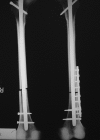Comparison of mechanical rigidity between plate augmentation leaving the nail in situ and interlocking nail using cadaveric fracture model of the femur
- PMID: 20213515
- PMCID: PMC3066311
- DOI: 10.1007/s00264-010-0983-y
Comparison of mechanical rigidity between plate augmentation leaving the nail in situ and interlocking nail using cadaveric fracture model of the femur
Abstract
Thirteen matched pairs of cadaveric femurs were placed into two groups. In each group, a transverse fracture was created at a point 70% distal between the lesser trochanter and the adductor tubercle. One femur out of each matched pair was then stabilised with an interlocking intramedullary nail (nail only group) and the other femur was stabilised with plate augmentation after interlocking intramedullary nailing (plate augmentation group). The bending load to promote 5-mm displacement showed statistically significant differences between the plate augmentation group (mean 843.36 ± 409.13 N) and the nail only group (mean 315.02 ± 219.80 N) (p = 0.001). Torsional torque at the angle of 15 degrees showed statistically significant differences between the two groups; a mean of 2.09 ± 0.53 N·m for the plate augmentation group and a mean of 0.63 ± 0.46 N·m for the nail only group (p = 0.0001). We found a 2.6-fold increase in bending stiffness and a 3.3-fold increase in torsional stiffness in plate augmentation leaving a nail in situ compared to interlocking nailing only in the distal third fracture of femur.
Figures





Similar articles
-
Retrograde intramedullary nails with distal screws locked to the nail have higher fatigue strength than locking plates in the treatment of supracondylar femoral fractures: A cadaver-based laboratory investigation.Bone Joint J. 2014 Jan;96-B(1):114-21. doi: 10.1302/0301-620X.96B1.31135. Bone Joint J. 2014. PMID: 24395321
-
Comparative biomechanical analysis of supracondylar femur fracture fixation: locked intramedullary nail versus 95-degree angled plate.J Orthop Trauma. 1997 Jul;11(5):344-50. doi: 10.1097/00005131-199707000-00008. J Orthop Trauma. 1997. PMID: 9294798 Clinical Trial.
-
Mechanical comparison of a distal femoral side plate and a retrograde intramedullary nail.J Orthop Trauma. 2000 Aug;14(6):398-404. doi: 10.1097/00005131-200008000-00004. J Orthop Trauma. 2000. PMID: 11001413
-
Comparison of Less Invasive Stabilization System Plate and Retrograde Intramedullary Nail in the Fixation of Femoral Supracondylar Fractures in the Elderly: A Biomechanical Study.Orthop Surg. 2019 Apr;11(2):311-317. doi: 10.1111/os.12449. Epub 2019 Apr 15. Orthop Surg. 2019. PMID: 30989797 Free PMC article.
-
Setscrew distal locking for intramedullary nails: a biomechanical study.J Orthop Trauma. 2000 Aug;14(6):414-9. doi: 10.1097/00005131-200008000-00006. J Orthop Trauma. 2000. PMID: 11001415
Cited by
-
Exchange K-nailing, Augmented Plating Technique for Atypical Femur Diaphyseal Non-union, and Implant Failure - A Case Report.J Orthop Case Rep. 2020 May-Jun;10(3):5-9. doi: 10.13107/jocr.2020.v10.i03.1724. J Orthop Case Rep. 2020. PMID: 33954125 Free PMC article.
-
[Research progress of augmentation plate for femoral shaft nonunion after intramedullary nail fixation].Zhongguo Xiu Fu Chong Jian Wai Ke Za Zhi. 2019 Dec 15;33(12):1467-1473. doi: 10.7507/1002-1892.201903073. Zhongguo Xiu Fu Chong Jian Wai Ke Za Zhi. 2019. PMID: 31823542 Free PMC article. Review. Chinese.
-
Intercalary reconstruction of long bones by massive allograft: Comparison of construct stability ensured by three different host-graft junctions and two types of fixations in a synthetic femur model.Front Pediatr. 2022 Aug 3;10:868299. doi: 10.3389/fped.2022.868299. eCollection 2022. Front Pediatr. 2022. PMID: 35989989 Free PMC article.
-
Plate augmentation and bone grafting in treatment of femoral shaft nonunion initially fixed by intramedullary nail.SICOT J. 2022;8:19. doi: 10.1051/sicotj/2022020. Epub 2022 May 23. SICOT J. 2022. PMID: 35608412 Free PMC article.
-
Analysis of the Feasibility of the OrthoNail Hybrid Intramedullary Implant in the Human Body with Respect to Material Durability.J Funct Biomater. 2025 Jan 15;16(1):27. doi: 10.3390/jfb16010027. J Funct Biomater. 2025. PMID: 39852583 Free PMC article.
References
-
- Bankston AB, Keating DA, Simon FD. The biomechanical evaluation of intramedullary nails in distal femoral shaft fractures. Clin Orthop. 1992;276:277–282. - PubMed
-
- Cole JD (1996) The vascular response of bone to internal fixation. In: Browner BD (ed) The science and practice of intramedullary nailing, 2nd edn. Willians and Wilkins, pp 43–69
Publication types
MeSH terms
LinkOut - more resources
Full Text Sources
Medical

